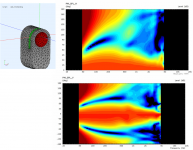I tried to double the number of mesh elements, my results are virtually the same. The resolution is obviously high enough already.should my vacs plots from unmodified script match your posts ? except for higher mesh frequency
BTW, there should be no need to increase the mesh frequency. Instead, in a case it's too low, increase the model resolution set in an Ath script (*Resolution items).
If it works for Dutch&Dutch, I don't see a reason why it should not work for anyone else.
The theory of LF directivity control using gradient loudspeakers was created long before the owner of D&D was born 🙂
https://www.aes.org/e-lib/online/browse.cfm?elib=1834
https://www.aes.org/e-lib/browse.cfm?elib=2006
https://secure.aes.org/forum/pubs/conventions/?elib=11549
I don't claim otherwise. It's just that there are not many speakers on the market utilizing the passive approach like in the 8c, that we are tring to model (including full data). Do you know any other implementations, so well documented?
Is there a simple way to script it as an MTM in quarter symmetry?ath.exe update - added option of the closed top, as shown in the above examples (BEE/Port/OpenTop=0):
I believe that understanding the general theory outlined in the above articles will lead to the desired result more quickly. But I won't interfere with the discussion.
This is an ABEC project template to put the T-S parameters of an acutal driver in and simulate the real (absolute) SPL levels, excursion, etc. In ABEC, simply set a path to your MSH file from a different project (Mesh files - Replace file...). You can then re-generate your project without affecting this one.

Attachments
Last edited:
The same could be said about the "horn theory" 🙂 How old is that?
I don't quite understand what you mean by putting "horn theory" in quotation marks, but the Horn theory has been helping to design different horns for almost a century 🙂
I'm still having (pilot?) errors in duplicating your results.I tried to double the number of mesh elements, my results are virtually the same. The resolution is obviously high enough already.
BTW, there should be no need to increase the mesh frequency. Instead, in a case it's too low, increase the model resolution set in an Ath script (*Resolution items).
View attachment 1133319
First try, my mouse skipped and I missed copying the SPL_V section at the bottom of the script and did only a 180 degree version. With that fixed, I get attached results from what should be identical script as you posted yesterday.
I notice that the Y offset in the abec drawing is different. My script has YOffset = -420.
with the attached MabatExampledFixed, my changes to z and w in the dipole opening section seem to be ignored.
Attachments
Needed a little touch.Is there a simple way to script it as an MTM in quarter symmetry?
https://at-horns.eu/ext/ath-4.9.0-pre-230122-2.zip
Code:
BEE = {
Height = 460 ; [mm]
Radius = 125 ; [mm]
Depth = 250 ; [mm]
Source = 90 ; diaphragm radius [mm]
YOffset = 105 ; [mm]
ZOffset = 40 ; [mm]
Resolution = 25,25,35,40 ; top-front, top-back, bottom-back, bottom-front [mm]
MTM = 1 ; 1/4 symmetry --> set YOffset = Height/2 + Radius
; dipole opening
Port = {
z = 25 ; [mm]
w = 40 ; [mm]
wt = 15 ; wall thickness [mm]
Resolution = 25 ; [mm]
Damping = 0.5 ; interior wall damping
OpenTop = 0
}
}
; don't mesh the waveguide
Mesh.WG = 0
; 1/4 symmetry
Mesh.Quadrants = 1Absolutely! Especially if you need a powerful horn for a train or a ship 🙂I don't quite understand what you mean by putting "horn theory" in quotation marks, but the Horn theory has been helping to design different horns for almost a century 🙂
I'm trying to dig up the oldest popular gradient loudspeaker, so far I've found this Altec 814A. If anyone know other vintage gradient loudspeakers, please post here !
https://www.lansingheritage.org/html/altec/specs/pro-speakers/814.htm
https://patents.google.com/patent/US3722616A/en
https://www.lansingheritage.org/html/altec/specs/pro-speakers/814.htm
https://patents.google.com/patent/US3722616A/en
"Let us assume the following conditions exist: (1) The
distance to the speaker from the remote point x is large
compared to the wave length of the sound being con
sidered; (2) the dimensions of the enclosure are small
compared to the wave length of the sound, ..."
OK, what do you do if the assumption (2) doesn't hold, as in our case? That's typically where a simple theory ends...
Generaly speaking, it depend on a shape of the the box. Obviuosly, that begining from a certain frequency the standing waves will appear inside the box and spoil the radiation pattern in the midband. However, this is a second order effect in gradient loudspeaker when it comes to directivity control at low frequencies. The first order effect we need to understand is how the time delay and distance between the back and front membrane side affects the on-axis frequency response and radiation pattern. The theory predicts this quite well.
Last edited:
If you upload a complete ABEC project as you have it, I can check that.I'm still having (pilot?) errors in duplicating your results.
You said there's a way that "leads to the desired result more quickly". Maybe we just have different targets, as I'm mostly interested in the secondary effects I think, i.e. in frequencies 200 - 2000 - that's where it's supposed to operate.Generaly speaking, it depend on a shape of the the box. [...] However, this is a second order effect in gradient loudspeaker when it comes to directivity control at low frequencies.
Here it is.If you upload a complete ABEC project as you have it, I can check that.
Thanks.
Attachments
I was able to reproduce it. Go to Options - Preferences - Processing and set NUC to None, restart ABEC and try again. If that doesn't help, I have no other idea.
- Home
- Loudspeakers
- Multi-Way
- Acoustic Horn Design – The Easy Way (Ath4)
